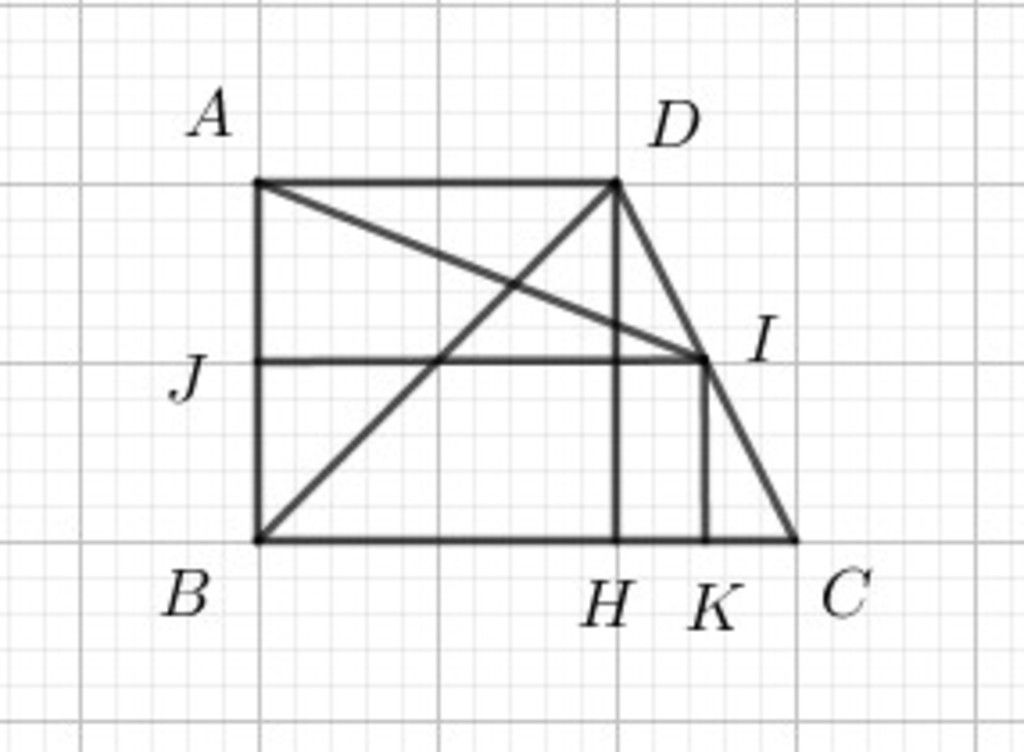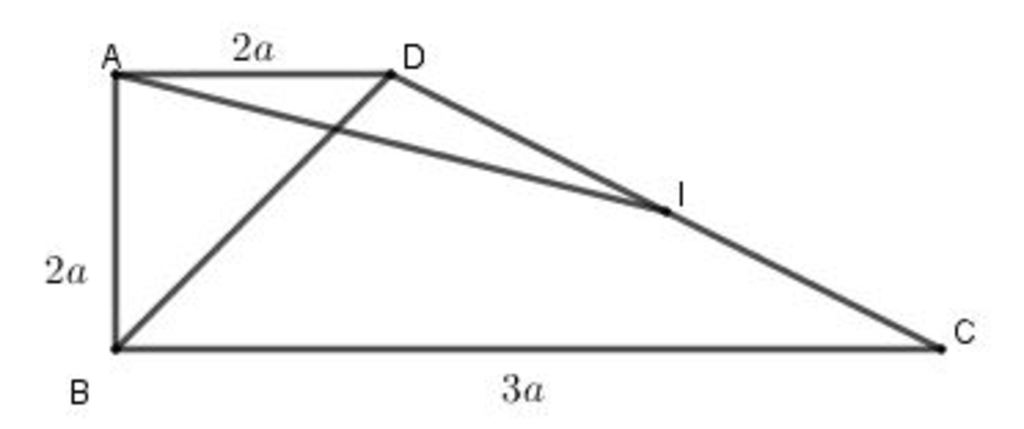Cho hình thang vuông ABCD, đường cao AB = 2a, đáy lớn BC = 3a, đáy nhỏ AD = 2a. Gọi I là trung điểm của CD, tính tích vô hướng: vectơ AI . vectơ BD. Suy ra góc của hai vectơ AI và vectơ BD.
2 câu trả lời
Đáp án:
\(\vec{AI}.\vec{BD}=3{a^2}\)
${(\vec{AI},\vec{BD})}=66,801^o$
Giải thích các bước giải:
$\begin{array}{l}
\overrightarrow {AI} = \dfrac{1}{2}\left( {\overrightarrow {AC} + \overrightarrow {AD} } \right) = \dfrac{1}{2}\left( {\overrightarrow {AB} + \overrightarrow {BC} + \overrightarrow {AD} } \right)\\
= \dfrac{1}{2}\left( {\overrightarrow {AB} + \dfrac{3}{2}\overrightarrow {AD} + \overrightarrow {AD} } \right) = \dfrac{1}{2}\overrightarrow {AB} + \dfrac{5}{4}\overrightarrow {AD} \\
\overrightarrow {BD} = \overrightarrow {BA} + \overrightarrow {AD} = - \overrightarrow {AB} + \overrightarrow {AD} \\
\Rightarrow \overrightarrow {AI} .\overrightarrow {BD} = \left( {\dfrac{1}{2}\overrightarrow {AB} + \dfrac{5}{4}\overrightarrow {AD} } \right).\left( { - \overrightarrow {AB} + \overrightarrow {AD} } \right)\\
= - \dfrac{1}{2}A{B^2} - \dfrac{5}{4}\overrightarrow {AD} .\overrightarrow {AB} + \dfrac{1}{2}\overrightarrow {AB} .\overrightarrow {AD} + \dfrac{5}{4}{\overrightarrow {AD} ^2}\\
= - \dfrac{1}{2}.{\left( {2a} \right)^2} - \dfrac{5}{4}.0 + \dfrac{1}{2}.0 + \dfrac{5}{4}.{\left( {2a} \right)^2}\\
= 3{a^2}
\end{array}$
$\cos{(\vec{AI},\vec{BD})}=\dfrac{\vec{AI}\vec{BD}}{AI.BD}=\dfrac{3a^2}{\dfrac{a\sqrt{29}}{2}.2a\sqrt2}=\dfrac{3}{\sqrt{58}}$
$\Rightarrow {(\vec{AI},\vec{BD})}=66,801^o$
Trong đó:
Áp dụng định lý Pitago vào $\Delta $ vuông $ABD$ ta có:
$BD=\sqrt{AB^2+AD^2}=(2a)^2+(2a)^2=2a\sqrt2$
Gọi $J$ là trung điểm cạnh $AB$
$\Rightarrow IJ$ là đường trung bình hình thang $ABCD\Rightarrow IJ\parallel AD$
Dựng $IK\parallel AB$
$H$ là hình chiếu của $D$ lên $BC$
$\Rightarrow IK$ là đường trung bình $\Delta DCH$
$\Rightarrow K$ là trung điểm của $HC$
$\Rightarrow BK=BH+HK=2a+\dfrac{a}{2}=\dfrac{5a}{2}=IJ$
$\Rightarrow IJ\bot AB$
Áp dụng định lý Pitago vào $\Delta $ vuông $AIJ$ ta có:
$AI=\sqrt{AJ^2+IJ^2}=\sqrt{a^2+(\dfrac{5a}{2})^2}=\dfrac{a\sqrt{29}}{2}$

Đáp án:
\(3{a^2}\)
Giải thích các bước giải:
$\begin{array}{l}
\overrightarrow {AI} = \dfrac{1}{2}\left( {\overrightarrow {AC} + \overrightarrow {AD} } \right) = \dfrac{1}{2}\left( {\overrightarrow {AB} + \overrightarrow {BC} + \overrightarrow {AD} } \right)\\
= \dfrac{1}{2}\left( {\overrightarrow {AB} + \dfrac{3}{2}\overrightarrow {AD} + \overrightarrow {AD} } \right) = \dfrac{1}{2}\overrightarrow {AB} + \dfrac{5}{4}\overrightarrow {AD} \\
\overrightarrow {BD} = \overrightarrow {BA} + \overrightarrow {AD} = - \overrightarrow {AB} + \overrightarrow {AD} \\
\Rightarrow \overrightarrow {AI} .\overrightarrow {BD} = \left( {\dfrac{1}{2}\overrightarrow {AB} + \dfrac{5}{4}\overrightarrow {AD} } \right).\left( { - \overrightarrow {AB} + \overrightarrow {AD} } \right)\\
= - \dfrac{1}{2}A{B^2} - \dfrac{5}{4}\overrightarrow {AD} .\overrightarrow {AB} + \dfrac{1}{2}\overrightarrow {AB} .\overrightarrow {AD} + \dfrac{5}{4}{\overrightarrow {AD} ^2}\\
= - \dfrac{1}{2}.{\left( {2a} \right)^2} - \dfrac{5}{4}.0 + \dfrac{1}{2}.0 + \dfrac{5}{4}.{\left( {2a} \right)^2}\\
= 3{a^2}
\end{array}$


